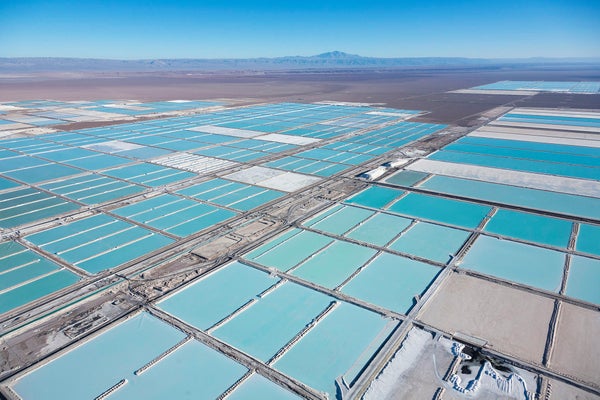In the middle of Chile’s Atacama Desert, 750,000 acres of bright blue and yellow squares filled with salty groundwater (brine) sprawl across a vast landscape. Pumped to evaporation ponds, the brine evaporates to leave behind a mixture rich in lithium and other salts. That mixture yields one of the key constituents of electric vehicle (EV) batteries. This brine mine, which has produced thousands of tons of lithium ultimately bound for China, the U.S. and other countries, consumes large amounts of water in a place where water is scarce. Brine mining has the potential to exacerbate drought conditions for local communities and affect local wildlife: the Atacama mine puts water supplies for nearby Indigenous communities at risk and has contributed to dramatic declines in flamingo populations.
The Chilean mine is no outlier to the potential impacts of critical mineral mining. Cobalt mining has led to human rights abuses in the Democratic Republic of the Congo (DRC). And fishers in Indonesia have said that local nickel mining and processing have destroyed their fishing grounds and livelihood. Environmental justice concerns potentially loom here in the U.S., too, where 79 percent of the country’s lithium reserves are within 35 miles of Native American reservation lands, ones already damaged from a long history of environmental injustices.
Given ambitious U.S. electric vehicle goals, our demand for lithium and other minerals critical to making these batteries will only grow. The federal government is trying to increase critical mineral supplies through both international agreements and accelerated domestic mining. But given the potential for critical mineral mines to affect human rights, water quality and availability, the health of native species and air quality, the sustainability of mineral extraction must be at the center of policymaking. We do not want to trade one harm—emissions from gasoline vehicles—for the harm caused by unsustainable mining practices to support EVs.
On supporting science journalism
If you're enjoying this article, consider supporting our award-winning journalism by subscribing. By purchasing a subscription you are helping to ensure the future of impactful stories about the discoveries and ideas shaping our world today.
In the rush to deploy electric vehicles to meet electrification goals, the U.S. must not ignore the harm that unsustainable mining practices can inflict on the environment and local communities like those in the DRC. For the U.S. to transition toward EVs that contain minerals produced in an environmentally and socially responsible manner, the nation must invest in mineral extraction innovations.
Fortunately, real and increasingly feasible alternatives to harmful mining practices are coming. If we continue to invest in them, we can sustainably build the EVs that will advance us toward our electrification goals.
In our research, three technologies have attracted our attention. The first, direct lithium extraction, is a new technology where lithium-rich water (brine) is pumped into a processing unit. Through chemistry relying on adsorption and the use of equipment such as filters and ion-exchange membranes, companies extract lithium and reinject the water, now cleaner, back into the aquifer. Such methods would ensure that people and wildlife have access to the water that they need.
Direct lithium extraction offers an interesting domestic application in the Salton Sea, a highly saline and polluted body of water in California that currently releases significant air pollution in local communities. If successfully commercialized, direct lithium extraction promises to improve production yields from the 40 to 50 percent with existing methods to greater than 80 percent; this method would also take less time and reduce land and water needs, compared with conventional brine mining. The potential here is massive—new analyses suggest that direct lithium extraction in the Salton Sea could provide lithium for more than 375 million EV batteries, about 24 times current production levels globally.
The ocean floor presents another promising alternative. There, an abundance of small rocks rich in minerals could be extracted for processing into critical minerals. While traditional seabed mining relies on dredging, which can destroy the seabed, new innovative techniques that avoid these damages are being developed. These techniques use artificial intelligence and robots to select these small rocks from the seabed without harming the surrounding marine environment. They also leave behind many of these rocks, which are beneficial for small sea creatures.
On the back end of the production line, recycling will be vital to prevent environmental degradation from batteries in landfills and to reduce the need for mining. Recycling can produce its own environmental impacts, but a new water-based system reduces its risk of fires and chemical leaching.
These examples demonstrate how technological innovation can help electrify our vehicles while reducing the potential harm to communities and the environment. If the federal government invests in these innovations and others, we can achieve national electrification goals and avoid disturbing Indigenous lands and local communities with harmful mining practices. Of course, we must ensure that these technological innovations provide us with the benefits we need without further contributing to environmental degradation. But the apparent trade-off between either sticking with gasoline vehicles or damaging the environment through unsustainable mining practices is a false dichotomy. We have other options.
This is an opinion and analysis article, and the views expressed by the author or authors are not necessarily those of Scientific American.
